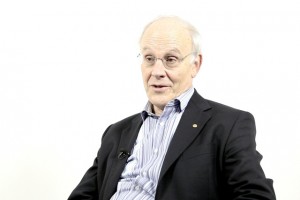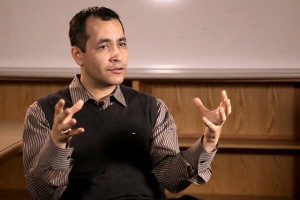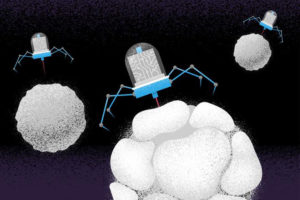Quantum Chromodynamics
Nobel Prize laureate David Gross on Rutherford experiments, asymptotic freedom, and the origin of the particle...
What is the difference between laser and evaporative cooling? What is the physical basis for the frequency shift? How does ultracooling expand our knowledge of electrons? MIT Professor of Physics Wolfgang Ketterle talks on new possibilities for material scientists.
Why are researchers interested in cooling atoms? Why do we want to accomplish atomic gases at lower and lower temperature? Well, in atomic physics the objects of our study are atoms, and at room temperature atoms fly around like air molecules in this room at the speed of sound which is the speed of a jet airplane. So historically atomic physicists studied atoms which fly by at the speed of a jet airplane. And of course it’s obvious, if you want to study the atoms more carefully, wouldn’t it be great if these atoms move more slowly or would even stand still? Then you could have a much closer look at the atoms and determine the properties of atoms with much higher precision.
One reason why you want to do precision measurement on atoms is that atoms serve as atomic clocks. The most accurate clocks, which we know, are atomic clocks. I mean, a clock is something which ticks, but the ticking of a quartz oscillator or the ticking of a pendulum is not as reproducible as the ticking within an atom, which is an oscillation within the atom. And therefore for many, many years now atomic motion, atomic ticking, atomic transition frequencies provide the time and frequency standard, and this has been adopted by all the nations.
So laser cooling started in the 80’s. They’ve pretty soon, in the mid-80’s, cooled atoms to really millikelvin and microkelvin temperature. And this almost immediately improved the precision of atomic clocks. But then people asked questions: what would happen if you can go even colder? Well, when we go even colder with a gas of particles, we reach the regime of quantum statistics and then, at low temperatures, when the gas becomes degenerate – those temperatures are typically in the nanokelvin range – it makes a big difference whether the atoms are bosons or fermions. If they are fermions, they form a degenerate Fermi sea – it’s a form of matter which is very similar to electrons in solids. Or, when they are bosons they undergo the phase transition to Bose-Einstein condensation, which is a superfluid gas, which has some properties in common with superfluid liquid helium.
The timeline of laser cooling is that there were suggestions in the late 70’s that it would be possible to cool matter with laser light. That was realized in the early and mid 80’s, and laser cooling really took off in the late 80’s, when several of the powerful cooling techniques, which we are using up to the present, were developed, and it was actually for the developments in the late 80’s that three the pioneers received the Nobel Prize in Physics 1997.
Laser cooling is actually something which is fascinating by itself.
If you ask people what happens when you shine laser light on matter, people think: laser will heat up matter, because it’s a directed form of energy.
Well, this is correct, lasers are used for material processing, they’re used for laser welding, so you can transfer a lot of energy with lasers. However, atoms are different: when atoms absorb a photon, they have no other choice than to re-emit the photon in the form of fluorescence. So now you would see, when it comes to atoms, lasers are sort of neutral, because energy in – energy out, photon in – photon out.
But this gives us now the possibility to play, to exploit small differences: if the colour of the light which is absorbed and which is emitted is slightly different, if there’s a frequency shift between the absorbed and the emitted light, then these frequency differences, energy difference can be used for cooling. And when we do laser cooling, we have to make sure that the photon which is emitted has slightly higher energy than the photon which was absorbed, and then every time an atom absorbs and emits a photon some of the atom’s energy is radiated away and the atom gets colder, and colder, and colder.
And the simplest example for frequency shift between absorption and emission is caused by the Doppler shift. Just the Doppler shift due to the motion of the atom, which makes sure that light emitted in different directions has different frequencies, and this can be exploited to do one form of laser cooling.
So laser cooling techniques to create microkelvin temperatures were developed in the late 80’s, and then there was the dream of Bose-Einstein condensation, of going further down, going from microkelvin into the nanokelvin range. People tried to find all sorts of sophistications of laser cooling, but what ultimately turned out to be the successful approach was evaporative cooling.
Evaporative cooling is much simpler to explain than laser cooling, because it happens in our normal environment. If a cup of coffee quick cools down, it cools down for several reasons, but one reason is that the most energetic water molecules escape from your coffee in the form of steam, and if the most energetic molecules escape, then those which stay behind, have on average less energy than they had before, and that means they are colder. So by simply selectively removing the hottest particles from your ensemble you cool your ensemble. And that’s exactly what we do when we apply evaporative cooling to atoms – we let the most energetic atoms escape, and by optimizing the process the remaining atoms cool down eventually to nanokelvin temperatures and to Bose-Einstein condensation.
So a lot of people thought it will never be possible to start with laser cooling and continue with evaporative cooling. But in the years which were leading to the realization of Bose-Einstein condensation – ultimately the Nobel Prize discovery – people learned how to optimize both laser cooling and evaporative cooling, and close the gap. And now the standard technique is we start with laser cooling, and then the evaporative cooling takes over and cools down to Bose-Einstein condensation.
Today we often talk about quantum simulation. We are using ultracold atoms as a quantum simulator for new materials. Richard Feynman had a vision that one quantum system could be simulated by another one. Well, if you have one system which is hard to manipulate, hard to study, but you have another system of particles which follow the same equations, then you can study the physics with the other system.
And, to some extent, that’s what we’re doing with ultracold atoms. So, we want to understand strongly correlated materials, interesting materials like high-Tc superconductors, magnetic materials, we want to understand the behaviour of charged particles in very high magnetic fields. So there are lots of, you know, interesting forms of matter which are not yet fully understood.
And one way to understand it would be to build, you can see, a model of this form of matter using atomic Lego pieces. And then with a quantum simulation we have built the form of matter we are interested in, piece by piece, almost atom by atom out of ultracold atoms, and then the ultracold atoms behave exactly as electrons in a high magnetic field. And therefore by studying ultracold atoms we can learn something about the behaviour of electrons in high magnetic field without ever creating these high magnetic fields, because we have created a simulator, we have created a model where the same equations apply now to ultracold atoms. Or to explain it differently, in the field of ultracold atoms a quantum simulator is a Lego game, a game where we play Legos with ultracold atoms. So the ultracold atoms can be regarded as Lego pieces, and we can now arrange these atomic Legos in many new ways. And in this way we can realize new materials.
I often regard using ultracold atoms as Lego pieces as a way to figure out what is possible in nature.
If you have an idea that ‘wow, there could be a new form of matter’, if you make particles behave in such and such way and the forces between the atoms, but you don’t know where to find this matter in nature, maybe you can build it with atomic Lego? And then you can figure out if your concept, if your idea is correct, and you can figure out if it is possible, at least in principle, that nature is realizing this new material with new properties.
So once you have shown using atomic Legos, using an atomic quantum simulator that this form of matter is possible in nature, you’ve learned something about new possibilities in nature. And that provides a motivation for materials research to possibly create materials with similar properties, but at higher temperature and higher densities in the real world and, possibly, for applications. So this is where research on ultracold atoms will most likely lead to application. The insight about new materials, mapping out possibilities for new materials in nature, well, they lead to applications, because they may inspire material scientists over time scale, which can be ten, twenty or thirty years, to realize new materials. Because we know now, based on the research with ultracold atoms, what is possible in nature.

Nobel Prize laureate David Gross on Rutherford experiments, asymptotic freedom, and the origin of the particle...

Bioengineer Ali Khademhosseini on creating new biomaterials, microengineering, and mimicking embryonic develop...

Professor of Physical Chemistry Peer Fischer on nanorobots, why are they so hard to work on and what might be ...